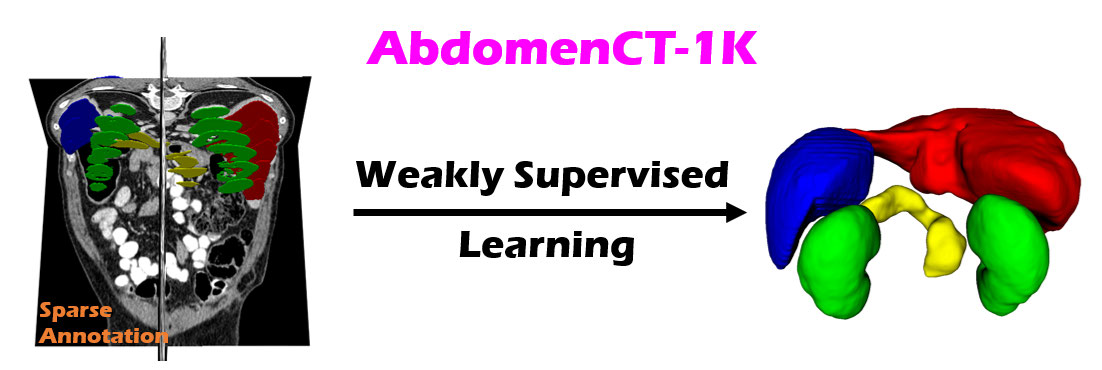AbdomenCT-1K: Weakly Supervised Learning Benchmark
Abdominal organ segmentation plays an important role in clinical practice, and to some extent, it seems to be a solved problem because the state-of-the-art methods have achieved inter-observer performance in several benchmark datasets [1-3]. However, it is unclear whether the excellent performance can be generalized on more diverse datasets. Moreover, to alleviate the dependency on annotations, semi-supervised learning, weakly supervised learning, and continual learning have been active research topics, but there are still no segmentation benchmarks for these tasks.
To address these limitations, we establish four benchmarks for multi-organ segmentation, including:
- AbdomenCT-1K: Fully Supervised Learning Benchmark
- AbdomenCT-1K: Semi-supervised Learning Benchmark
- AbdomenCT-1K: Weakly-supervised Learning Benchmark
- AbdomenCT-1K: Continual Learning Benchmark
Annotating multiple organs in 3D abdomen CT scans is time-consuming and labor-intensive while only annotating some slices is affordable. Therefore, we set up AbdomenCT-1K: Weakly Supervised Learning Benchmark for multi-organ segmentation, which aims to explore how we can use weak annotations to generate full segmentation results.
Participants are required to develop weakly supervised segmentation methods that can segment the liver, kidney, spleen, and pancreas simultaneously. This benchmark consists of 3 subtasks with different annotation ratios (5%, 15%, 30%).
How to participate
- Click on the Join button.
- Download the training and testing data on the Dataset page.
- Develop your solution and make a complete submission (including a zip file of segmentation results and a short paper).
Evaluation Metrics
- Dice Similarity Coefficient (DSC)
- Normalized Surface Dice (NSD)
The implementation is available here.
Rules
- All participants should register this challenge with their real names, affiliations, and affiliation E-mails. Incomplete and redundant registrations will be ignored without notice.
- For a fair comparison, participants are not allowed to use any additional data and pre-trained models.
- Participants are not allowed to register multiple teams and accounts
Reference
[1] P. Bilic, P. F. Christ, E. Vorontsov, G. Chlebus, H. Chen, Q. Dou, C.-W. Fu, X. Han, P.-A. Heng, J. Hesser et al., "The liver tumor segmentation benchmark (lits)," arXiv preprint arXiv:1901.04056, 2019.
[2] F. Isensee, P. F. Jaeger, S. A. A. Kohl, J. Petersen, and K. H. Maier-Hein, "nnu-net: a self-confifiguring method for deep learning" based biomedical image segmentation,” Nature Methods, vol. 18, no. 2, pp. 203–211, 2021.
[3] N. Heller, F. Isensee, K. H. Maier-Hein, X. Hou, C. Xie, F. Li, Y. Nan, G. Mu, Z. Lin, M. Han et al., “The state of the art in kidney and kidney tumor segmentation in contrast-enhanced ct imaging: Results of the kits19 challenge,” Medical Image Analysis, vol. 67, p. 101821, 2021.
